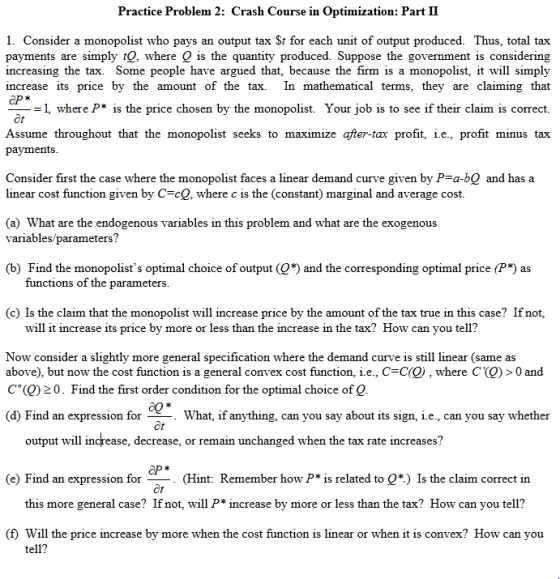Answered step by step
Verified Expert Solution
Question
1 Approved Answer
Practice Problem 2: Crash Course in Optimization: Part II 1. Consider a monopolist who pays an output tax $t for each unit of output

Practice Problem 2: Crash Course in Optimization: Part II 1. Consider a monopolist who pays an output tax $t for each unit of output produced. Thus, total tax payments are simply to, where Q is the quantity produced. Suppose the government is considering increasing the tax. Some people have argued that, because the firm is a monopolist, it will simply increase its price by the amount of the tax. In mathematical terms, they are claiming that ap* -=1, where P* is the price chosen by the monopolist. Your job is to see if their claim is correct. at Assume throughout that the monopolist seeks to maximize after-tax profit, i.e., profit minus tax payments. Consider first the case where the monopolist faces a linear demand curve given by P=a-bQ and has a linear cost function given by C=cQ, where c is the (constant) marginal and average cost. (a) What are the endogenous variables in this problem and what are the exogenous variables/parameters? (b) Find the monopolist's optimal choice of output (Q*) and the corresponding optimal price (P*) as functions of the parameters. (c) Is the claim that the monopolist will increase price by the amount of the tax true in this case? If not, will it increase its price by more or less than the increase in the tax? How can you tell? Now consider a slightly more general specification where the demand curve is still linear (same as above), but now the cost function is a general convex cost function, i.e., C=C(O), where C(O)> 0 and C" (Q) 20. Find the first order condition for the optimal choice of Q. (d) Find an expression for Q* What, if anything, can you say about its sign, i.e., can you say whether at output will increase, decrease, or remain unchanged when the tax rate increases? ap* (e) Find an expression for (Hint: Remember how P* is related to Q*.) Is the claim correct in this more general case? If not, will P* increase by more or less than the tax? How can you tell? t (f) Will the price increase by more when the cost function is linear or when it is convex? How can you tell?
Step by Step Solution
★★★★★
3.31 Rating (139 Votes )
There are 3 Steps involved in it
Step: 1
1 Consider a monopolist facing an output tax a Endogenous and Exogenous Variables Endogenous Quantit...
Get Instant Access to Expert-Tailored Solutions
See step-by-step solutions with expert insights and AI powered tools for academic success
Step: 2

Step: 3

Ace Your Homework with AI
Get the answers you need in no time with our AI-driven, step-by-step assistance
Get Started


